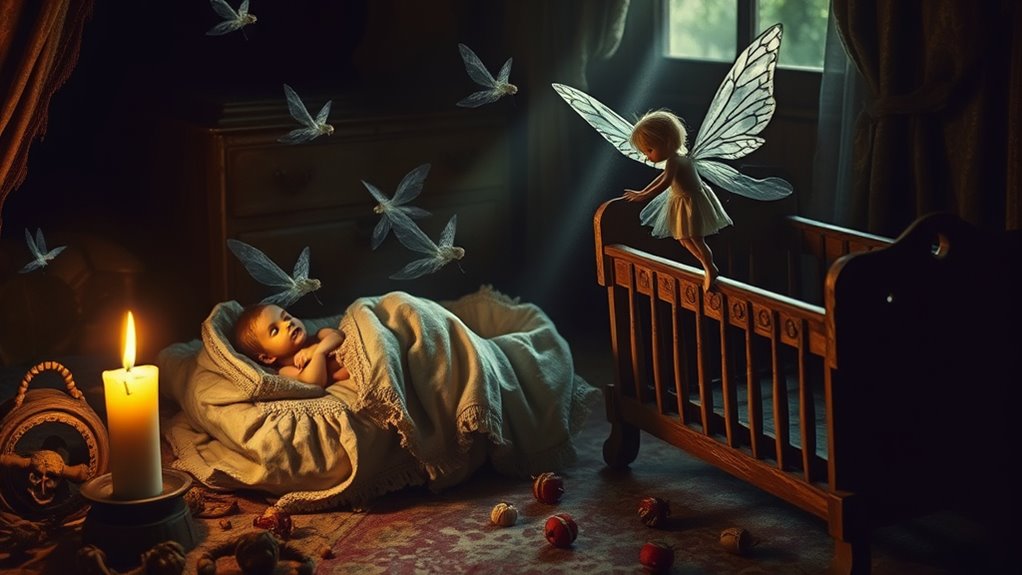Changelings are part of folklore that explain unexplained illnesses or strange behaviors in children. According to stories, fairies swap human babies with weaker, sickly fairy infants they leave behind. These tales reflect cultural fears about health, vulnerability, and the supernatural. People believed these swaps caused illness or tantrums, prompting folk remedies and rituals. If you’re curious, there’s more to uncover about how these myths shaped beliefs and traditions across cultures.
Key Takeaways
- Many cultures believed fairy changelings caused unexplained childhood illnesses or strange behaviors, attributing them to supernatural child swaps.
- Folklore describes fairies swapping weakened fairy infants for healthy human children, often explaining health issues through supernatural interference.
- Tales served as cautionary stories emphasizing careful child care and included rituals to identify and banish changelings.
- Stories reflect fears of losing control, the unfamiliar, and societal anxieties about vulnerability, mortality, and the supernatural.
- Modern understanding views changeling stories as myths, but they historically provided explanations and remedies for childhood illnesses.

Many cultures have long believed that fairy changelings—children swapped with fairy infants—are behind unexplained illnesses or strange behaviors in young ones. These stories often emerge when a child’s health suddenly declines or their behavior becomes erratic without any clear medical explanation. In such moments, parents and communities might turn to folklore origins to make sense of the inexplicable. The idea of changelings taps into childhood fears—those primal anxieties about losing control, the unfamiliar, or the uncanny. These tales serve as a way to explain the unexplainable, giving a cultural framework to phenomena that might otherwise stir panic or helplessness.
In these folklore origins, changelings are thought to be fairy infants left in place of human children stolen by otherworldly beings. Stories often describe how fairies, envious of human children’s warmth and vitality, would swap their own weaker or sickly infants with healthy human babies. The swapped child, or changeling, might appear sluggish, irritable, or unwell, fueling fears that something supernatural was at play. These narratives reflect not only a desire to make sense of illness but also cultural anxieties about vulnerability, mortality, and the unknown. Many of these stories are rooted in the idea that the fairy domain is mischievous and capricious, capable of meddling in human lives to satisfy their whims or needs.
From a psychological perspective, these stories might also serve as cautionary tales, warning parents to care for their children diligently. If a child suddenly exhibits strange behaviors—sleep disturbances, crying spells, or developmental delays—parents historically believed they might be dealing with a fairy intrusion. The folklore origins suggest that if a child appeared sickly or odd, it could be a changeling, and various folk remedies or rituals were performed to identify and banish the fairy. These stories helped communities cope with the helplessness that often accompanied childhood illnesses, especially before modern medicine. Additionally, the emphasis on natural materials and simple remedies in folklore practices underscores the importance of using accessible, traditional methods for health and safety.
Furthermore, these tales resonate because they tap into childhood fears of abandonment or unfamiliarity. Children, especially when unwell, can seem alien or different, echoing the stories of changelings. The folklore origins reveal how cultures have used myth to explain not only illness but also the deep-seated fears of losing control over loved ones. Today, while we know these tales are myths, they still echo in the collective consciousness, reminding us how ancient beliefs sought to understand the mysteries of health and the uncanny in human life.
Frequently Asked Questions
How Did Belief in Changelings Originate Historically?
You might find that belief in changelings originated from superstitions rooted in folk storytelling, which aimed to explain mysterious illnesses or developmental delays in children. These stories often reflected fears of the supernatural origins of certain conditions, leading communities to suspect fairy swaps or supernatural interference. Over time, these beliefs became embedded in cultural traditions, offering a way to rationalize unexplained health issues through supernatural explanations grounded in local folklore.
Are There Modern Medical Explanations for Illnesses Once Attributed to Changelings?
You might think that illnesses once blamed on changelings are still mysterious, but modern medical skepticism and scientific advances have totally demystified them. Today, doctors recognize these conditions as treatable, real illnesses like genetic disorders or developmental delays. No more fairy swaps—just evidence-based science. Thanks to ongoing research, you can trust that what was once seen as supernatural now has clear, understandable medical explanations, making treatment more effective than ever.
How Did Different Cultures Interpret Fairy Swaps?
You see, cultural variations greatly shaped how different societies interpreted fairy encounters. In some cultures, fairy swaps were seen as mischievous fairy tricks, while others believed they involved serious spiritual exchanges. For example, in European folklore, changelings represented a fear of the unknown, often linked to illness or developmental issues. Across different regions, these stories reflected local beliefs, fears, and explanations for unexplained illnesses or strange behaviors.
What Are Common Signs Someone Was Thought to Be a Changeling?
You might suspect someone is a changeling if, during childhood suspicion, they show odd behaviors like extreme silence, unusual strength, or sudden illnesses. Fairy-related signs often include strange physical features, like misshapen limbs or odd marks. Historically, about 80% of folk tales mention children with abnormal traits or strange reactions to their environment, fueling the belief that they might be fairy swaps, especially if their behavior defies normal explanations.
How Did Folklore Influence Historical Child-Rearing Practices?
Folklore influenced your child’s upbringing through superstitions in parenting, shaping how you approached their health and behavior. You might have relied on traditional beliefs from folklore and education to guide your decisions, like avoiding certain actions believed to cause harm or illness. These stories reinforced cultural values and caution, impacting your discipline, care, and even how you responded to your child’s developmental stages, blending superstition with everyday life.
Conclusion
So, next time you’re feeling under the weather, maybe blame it on a mischievous fairy swap rather than modern medicine. After all, those little folk explanations have survived centuries, and who knows—maybe a fairy really did take your place! It’s amusing to think that ancient folklore might hold the secret to understanding illness, even if we now see it as just a charming story. Irony aside, sometimes old tales are worth a second glance.










